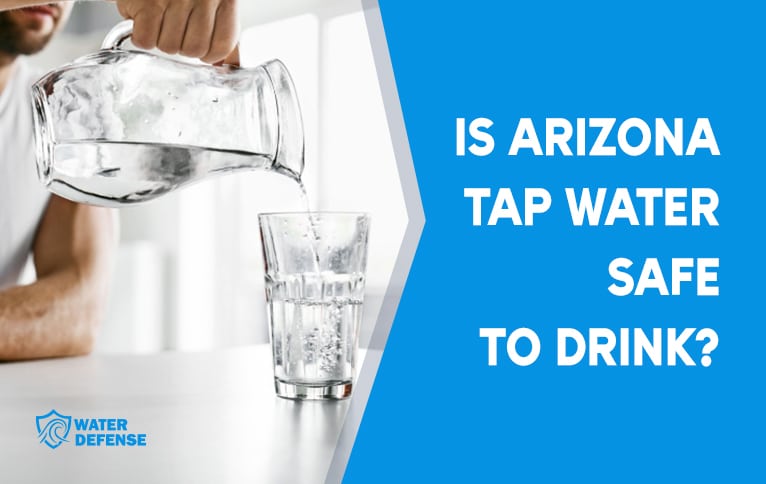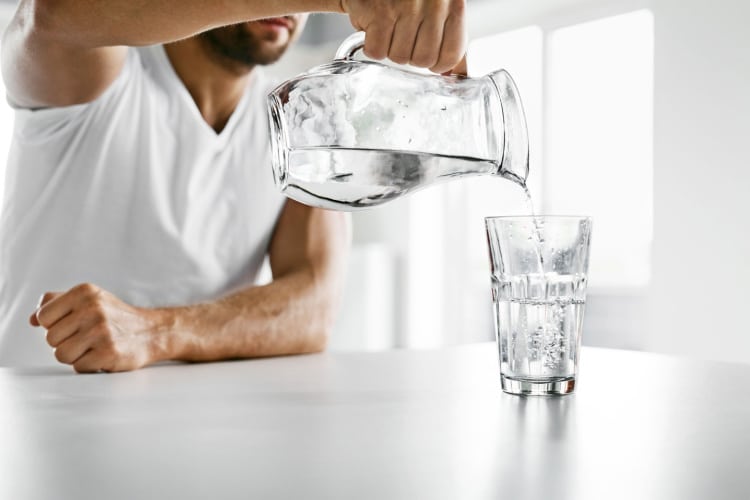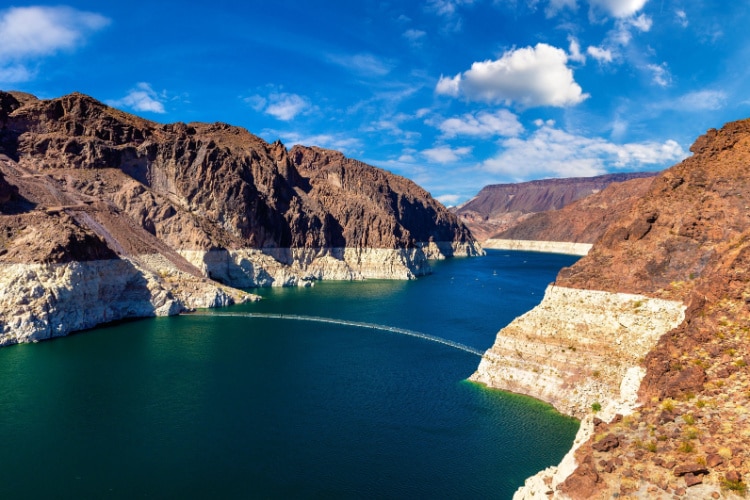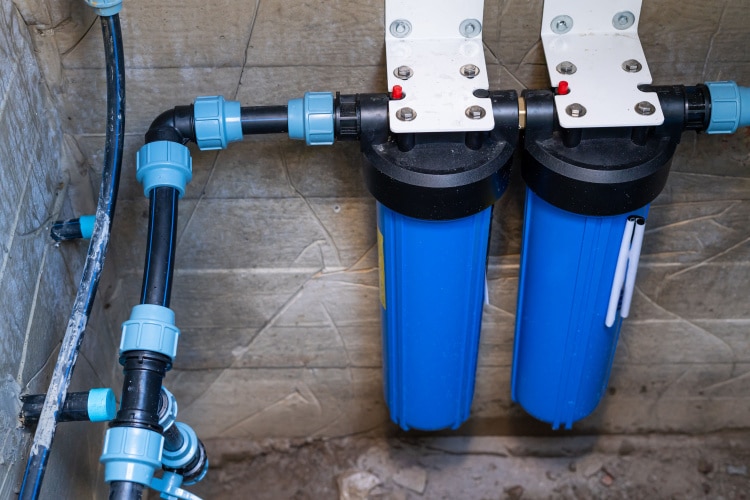The sixth largest state by land and the fourteenth most populous state in the United States, Arizona is home to 91 incorporated towns and cities. More than seven million people reside in the vast desert-scapes of this state.
The water quality across the land varies from municipality to municipality, but overall, most Arizonians don’t get safe water to drink. The state is in the third spot on our list of states with the worst water quality, and the news reports show that a number of municipal water facilities have shown contaminant presence well above the drinking water standards set by the Environmental Protection Agency (EPA).

But what’s in the water? And why does Arizona’s water keep getting contaminated so frequently that it’s unsafe to consume the water without testing and treating it at home?
In this article, we’re going to get to the bottom of these questions and share information about where Arizona gets its water from.
Arizona Water Quality Report: What’s in the Water?

There’s no single water quality report we may refer to when it comes to Arizona since all the 91 municipalities of the state release their own yearly reports. However, the Environmental Work Group (EWG) has gathered all that data and found out that at least more than two utilities have excess amounts of arsenic, total trihalomethanes (TTHMs), radium, uranium, nitrates, and perfluorinated substances.
Additionally, the individual water quality reports of the state’s biggest cities show lead presence in the water.
The lead presence is below the EPA action limit (the limit where the association issues warnings to the public and fines to the water supply companies and municipalities) of 15 parts per billion (ppb) in cities like Chandler, Mesa, and Tucson. But the latest reports show that at least three houses out of 71 have tap water that has higher lead levels than 15 ppb in the state’s biggest municipality and the fifth most populated city in the country, Phoenix.
Now, let’s see what these contaminants are, how they get into the water, and what you can do to eliminate them.
Lead
The EPA introduced a lead and copper rule in 1991, banning these heavy metals’ use in piping and plumbing components. But in big cities like Phoenix, most of the infrastructure had already been constructed before 1991, and now, it’s not practical or even affordable to replace a whole city’s problematic pipe components despite the best attempts of the authorities.
That’s why more than 4% of the city’s taps test above the EPA lead action limit of 15 ppb.
While these residencies are at immediate risk, the tap water in other municipalities where lead levels test below the EPA action limit isn’t completely safe either. The EPA and many other health authorities establish that “there’s no safe amount of lead in drinking water.” As such, the association sets its health goal for this heavy metal at zero under its National Primary Drinking Water Regulations (NPDWRs).
Our recommendation is to have your tap water tested by an EPA-certified lab or with a test kit you purchase. If the results are positive for lead, then you can implement a water treatment solution designed specifically for eliminating lead.
Arsenic
In Arizona, arsenic is everywhere. Although the households that rely on private wells for their water supply suffer most from this toxic metal (19% of Arizonian private wells have unsafe arsenic levels), the situation is no brighter when it comes to the municipal water supply.
According to the EWG report we shared above, at least fifteen water distribution utilities in Arizona have higher arsenic levels than the EPA action limit of 10 ppb. None of these utilities serve water in the big cities, but the arsenic levels in the big cities, like Gilbert, also reach up to 9 ppb in most cases. Considering the EPA health goal is zero for arsenic, 9 ppb is too much.
Most municipalities pinpoint the erosion of natural deposits as the number one cause for the arsenic presence in the municipal drinking water. But runoff from pesticide use in apple and peach orchards and electronic production waste are two other likely causes.
The good news is that you can purchase an arsenic water filter to prevent the adverse effects of consuming this heavy metal via drinking water.
Total Trihalomethanes
It’s general knowledge that municipal authorities treat their water before distributing it to citizens’ households. The last stage of this treatment typically consists of disinfection with chlorine, chloramines, or ozone to kill pathogenic microorganisms and prevent bacterial infestation.
However, when chlorine and chloramines enter into chemical reactions with organic matter, the reaction produces byproducts. The most common disinfection byproducts are haloacetic acids, bromate, and total trihalomethanes.
Although the first two don’t pose any immediate risks for Arizona citizens, the lattermost is a real concern.
The EPA safety limit for TTHMs is at 80 ppb, while its public health goal is zero. In the big Arizonian cities such as Gilbert, Tempe, and Phoenix, the TTHMs in water reach up to 90 ppb.
This is a serious problem because there are various scientific studies that link trihalomethanes in drinking water to an elevated risk of different types of cancer.
So, it’s best to keep an eye on your municipality’s water quality reports. If the reports show an alarming presence of TTHMs, take action by installing a relevant water filtration unit.
Radioactive Elements
The EWG report shows that Arizonian water has excessive levels of uranium and radium 226 & 228, testing above EPA limits in more than four utilities, which affects thousands of lives. And that’s no surprise because the state has a long history of uranium mining that started during World War II and peaked during the Cold War.
The people from the Navajo Nation were employed to mine uranium in Cove, Arizona, and the aftereffects of these mining practices still haunt indigenous towns in the state. The improper waste also caused uranium, selenium, and radium to leak into the underground aquifers of the whole region.
Additionally, a 1994 study shows that one of the biggest water sources of the state, the Little Colorado River, has radioactive substances in its basin. Especially the Puerco River, a tributary of the Little Colorado River, is very rich in radionuclides, which contributes to the makeup of Arizonian tap water and can cause problems.
Yet again, we recommend that you monitor your municipality’s water quality reports closely, run your own tests on a regular basis (twice a year), and, if you’re worried, install a water filtration unit to ease your concerns.
Nitrates
Similar to arsenic, nitrates are a big problem for Arizona’s groundwater, meaning private wells, due to fertilizers and improper wastewater management. However, the problem isn’t limited to well water in the state.
The EWG’s national nitrate analysis shows there are at least three municipalities within Arizona that have higher nitrate levels than the EPA action limit of 10 ppm: Florence, San Tan Valley, and Queen Creek.
High nitrate levels in drinking water imply a nitrate-rich diet, which is a health risk, especially for infants, as it may lead to blue baby syndrome. It has a wide variety of adverse effects in adults, too: elevated heart rate, muscle weakness, risk of colorectal cancer, and a heightened risk of tumors and carcinoma in the lungs, bladder, liver, and on the skin.
Bearing all that in mind, it’s best to have your water tested for nitrates and take precautions if necessary.
Perfluorinated Substances
Perfluorinated substances, which you may have heard of as PFAS, PFOA, or PFOS, are long-lasting chemicals utilized by a wide range of industries, from cookware to clothing, from food packaging to cosmetics and water- and grease-resistant products. Their omnipresence in nature and very slow degradation also means that they’re everywhere – in the soil, air, human and animal waste, in the ocean, in fish and marine life, and inevitably, in our water sources.
Recently, reports have showed alarming presences of PFOS and PFAS in nineteen different regions in Arizona, including big municipalities such as Tempe and Liberty. Most of it was due to leaks from firefighting foam, another substance that has PFOS and PFAS.
The EPA doesn’t yet regulate these chemicals because the agency is still in the research phase to determine safety levels and public health goals. But the early research suggests links to various health issues including high cholesterol, preeclampsia during birth, and elevated cancer risk.
So, if you live in an area where water tests show there are perfluorinated substances in your water, installing a PFAS filter is highly advised.
Water Hardness
The water in Arizona is extremely hard in the majority of municipalities, which comes as no surprise, as the United States water hardness map colors Arizona in red, indicating extremely hard water.
According to the United States Geological Survey (USGS), hard water has more than 60 parts per million (or mg/L) of calcium and magnesium content. When these minerals’ levels are between 60 mg/L and 120 mg/L, the water is moderately hard, when it’s between 120 mg/L and 180 mg/L, the water is hard, and when it’s above 180 mg/L, it’s extremely hard.
The water hardness in Arizona’s biggest city, Phoenix, for instance, ranges between 187 mg/L and 278 mg/L. When compared to Chandler’s hardness range of 230 mg/L to 431 mg/L, though, you may think that Phoenix citizens have it good.
Hard water doesn’t have any adverse effects on our health, but it can be inconvenient in other ways. It may lead to mineral buildup and clogging in pipes and appliances, it can stain laundry, dishware, and surfaces, and, if used as bathing water, it leads to dull hair and dry skin.
To prevent all that, it’s best to install a water softener. Fortunately, we have a list of the best water softening units you’ll find on the market.
Where Does the Tap Water Come in Arizona?

Arizona makes use of almost all the water sources it has available to supply its citizens.
54% of the Arizona tap water comes from surface water. A big part of this percentage belongs to the Colorado River, and it’s used as part of the Central Arizona Project, which has a right to 2.8 million acre feet of the river on an annual basis.
In-state rivers such as the Salt River and River Verde constitute the rest of Arizona’s surface water resources.
In addition, municipal water suppliers utilize underground aquifers. 41% of Arizona tap water comes from these aquifers. That percentage was much higher before the state passed a Groundwater Management Act in 1980 to protect its resources.
Lastly, reclaimed water, meaning treated wastewater, makes up the remaining 5% of Arizona’s municipal water supplies. However, reclaimed water is mostly used in irrigation, golf course and wildlife maintenance, and industrial cooling.
How Is Tap Water Treated in Arizona?

Be it for its rivers, aquifers, or wastewater, Arizonian municipalities treat their water in a multi-stage process:
- Pre-sedimentation: Before entering the municipalities’ water treatment facilities, the water is passed through big screens, so that the large particles such as rocks and stones are left behind.
- Coagulation, flocculation, and sedimentation: A chemical called coagulant is introduced to the water in a large tank. This chemical brings together impurities that have small particles in flocs. As a result of their newly acquired weight and volume, these flocs sink to the bottom of the tank as sediment.
- Filtration: The sediment-free water that remains at the top is transferred to another large tank. During this transfer, it passes through various water filters. Depending on the municipality and the contaminant levels, these filters may be reverse osmosis membranes or micro-filters.
- Disinfection: In the last stage, chlorine, chloramines, and sometimes ozone is pumped into the water to kill microorganisms.
You can head to our related guide for more information regarding tap water treatment in the United States.
You may ask why Arizonian tap water remains unsafe after all these treatment stages. Well, not all municipalities have access to the best treatment facilities and instruments. In addition, if the untreated water is contaminated too much, the filters can’t remove all the contaminants at once.
Conclusion: Do Arizonians Have the Safest Water?
No, the tap water isn’t safe in Arizona.
The biggest municipalities in the state, such as Phoenix, suffer from excessive lead presence in more than 4% of its taps.
The groundwater all across the state and more than fourteen towns and cities has hazardous arsenic levels.
In Gilbert, Tempe, and Phoenix, the total trihalomethane count reaches up to 90 ppb, which is 10 ppb more than the EPA’s action limit.
Both the underground aquifers and rivers within the state are contaminated with radioactive elements like uranium, which affects the state’s tap water content.
Nitrates and perfluorinated substances continuously test positive in Arizona’s tap water.
Our recommendation to Arizona citizens is to test their water by their own means at least twice a year and implement the relevant water treatment solutions.